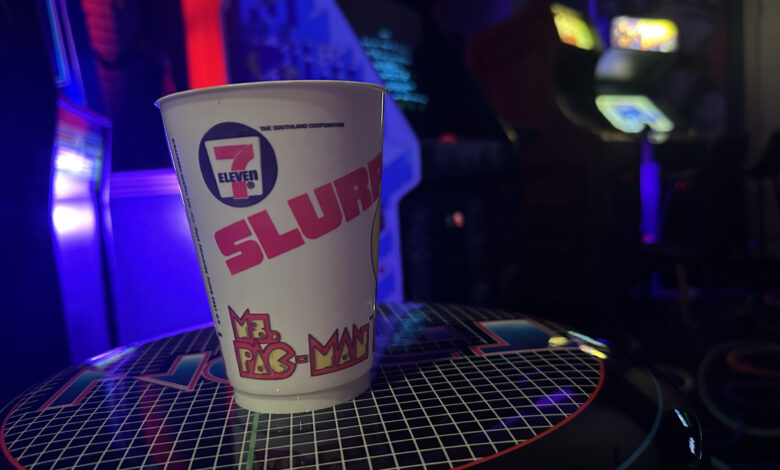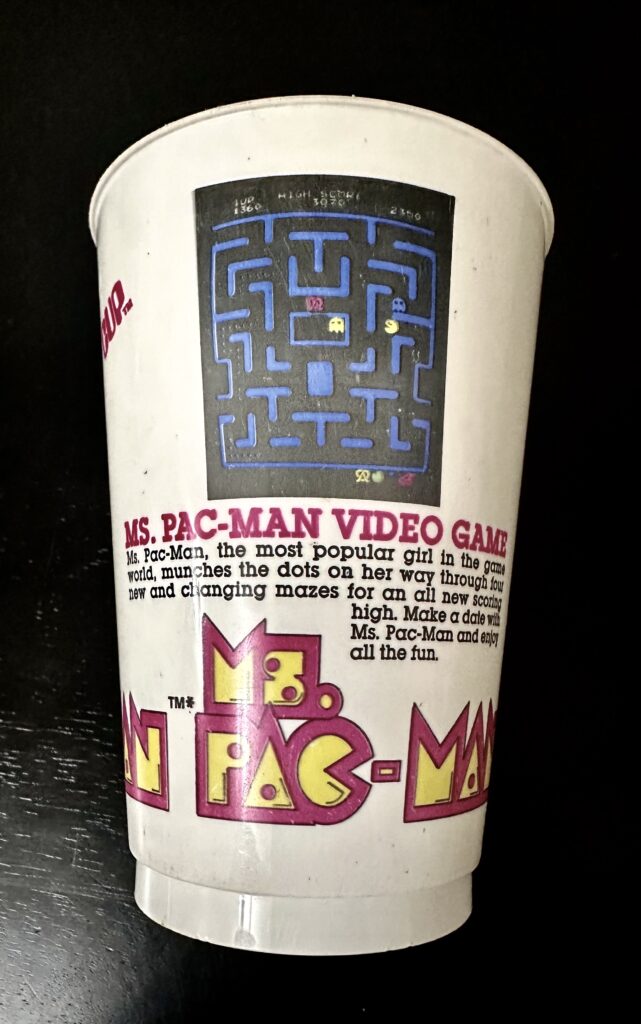7-11 Video game cups A 40-year cultural milestone
Video Game Invasion!

Nolan Bushnell and Ted Dabney, the founders of Atari, released the first arcade game, Computer Space, in 1971. It was followed a year later with the ground breaking Pong. Early critics of video games dismissed them as a fad, something that people would quickly lose interest in and forget within a year, two at the most. In fact Space Invaders was subject to one of the first political controversies over the ‘addictive nature’ of the medium all the way back in 1978.
But it was clear this new entertainment outlet was going to be more than that. Video games were changing the face of play, the perception of interaction for a whole generation, and they were going to leave a lasting mark on culture. And the surest sign that this was happening actually started through a promotion at convenience stores across the America.
7-11 chain stores introduced the Slurpee in 1966. The chilly carbonated drink, used in conjunction with the Icee corporation, but under a different name exclusive to the 7-11 locations, was a top seller from the start. In the mid 1970s, it began to align itself with popular societal trends. 1972 saw baseball players on the cups. In 1973, DC superheroes were featured. In 1975, Marvel superheroes were plastered on the cups. And this was the usual summer promotion, baseball, and comics, to appeal to the youth of the day. Then, in 1982, 7-11 introduced Slupree Video Cups.
A Refreshing Arcade Collectible
This year marks the 40th anniversary of the two year Slurpee Video Cup run, which started in mid 1982 and was so popular that it continued with a second wave into 1983. Many collectibles have emerged in the video game realm over the years from cards to buttons to figurines. But these cups were unique in their combination of promotion and collectability. They are still well-sought after on eBay and can command between $10 for slight cracks and faded graphics, to $50 in pristine condition.
For anyone who goes into a 7-11 today, the size of Slurpee cups goes from large, to very large, to ‘wow, that’s almost too big!’ Back in the early 80’s there was only one size you could get, and it was considerably smaller than what is even considered a small today! Measuring at 6 inches the cups were a relatively flimsy plastic. However, it was the graphics printed on the cups that made them special.
Two years of hits and misses
The initial wave of cups in 1982 all sported the banner Slurpee Video Cup with the branded 7-11 logo just above. 16 cups were released the first year. As video games were just hitting their stride, it was difficult to know which ones would have lasting success. The designers of the cups banked on a few popular titles and took a few risks with others. The first run featured Asteroids, Centipede, Defender, Frogger, Galaga, Galaxian, Pac-Man, Ms. Pac Man, Space Invaders, Omega Race, Robby Roto!, Robotron 2084, Space Duel, Tempest and Turbo, Zaxxon.
The cups were so popular that they returned a year later. The new wave of cups featured the same 7-11 logo and Slupree Video Cup branding, but right above the banner a ‘1983 Series’ graphic was added to differentiate them (and give rise to the rumor that this would continue yearly). The second wave included the return of Centipede, Galaga, Pac-Man and Ms. Pac Man but added Baby Pac-Man, Super Pac-Man, Donkey Kong, Donkey Kong Jr., Q-Bert, as well as Buck Rogers, Burgertime, Front Line, Joust, Jungle Hunt, Moon Patrol, and Popeye.
While the Pac Family are obvious winners that are still around today, and Donkey Kong gave the world Mario as well as the big DK who has several of his own series, it’s fun to see several of the lesser-remembered games represented. Galaga and its cousin Galaxian still have a decent following, as does Q-Bert and of course Asteroids and Space Invaders made their mark. But Front Line and Space Duel might only exist in memory for those that own these cups.
A shift in the cultural joystick

But above all else, why were these cups important? They were of inferior quality even by the standards of the day. Unless kept in a cool, climate-controlled environment, they cracked rather easily. The artwork washed off after only a few rounds in the dishwasher. What made them so unusually unique?
You must remember, up until then, Slurpee and 7-11 had focused on what was popular with kids and collectors to push their product. Baseball stars have always held sway, so that was a no-brainer. When comic books started hitting the silver era stride of the 1960s and 70s, they easily shifted to that market. They used tried and true heroes like DC’s Superman and Batman, then switched to the Marvel heroes who had made their mark the previous decade and were definitely changing the face of comics.
Just looking at the copyrights on the sides of the cups, you’ll see Nintendo, Atari, Sega, William’s Electronics, Bally Midway, and Taito. All the big names displaying their famous mascots, and quickly forgotten avatars (I’m looking at you Jungle Hunt) in the hopes of grabbing hold of the youth market. It might be the biggest video game crossover that has ever happened, well before Super Smash Bros. was even an idea.
Snapshot of a bygone era
Looking back, it’s easy to say, “Of course video games would be next, it was the start of that era.” But that wasn’t so clear at the time. These games were really seen as a passing fad. The fact that Slurpee went all in on these cups shows that they saw this cultural shift. These games had made such an impact that the demand would be there. 7-11 wanted to sell Slurpees, and they knew this would do it.
The naysayers were wrong in thinking video games wouldn’t last. Arcade cabinets made way for home systems, and from there an entire new subculture was born. ‘Gamer’ became a term embraced by old and young alike. But the 7-11 video game cups were an interesting moment in time, at the forefront of this shifting wave. They opened the door to licensing these game properties across a wide spectrum of items.
Their significance is more than just a cheap plastic container to hold a sugary, refreshingly, cold drink. It spoke to a whole new generation of kids that were just discovering what the next big thing was. The future of video games is definitely bright. But it’s good to take a moment to remember the trailblazing moments at the start of the journey.

